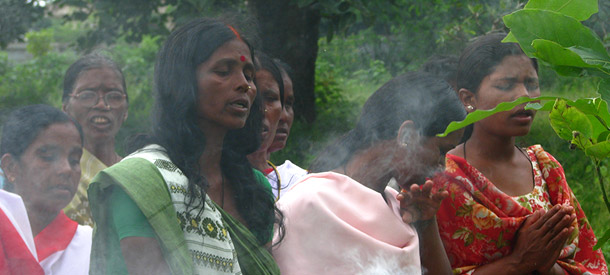East-Central India is home to a great number of sacred groves. It is believed that these groves house a deity called Sarna Mata. According to local beliefs, Sarna Mata has grown unhappy with the deterioration she has witnessed in these groves over the past decades. Now, she expresses herself in the minds of local indigenous women, in the form of possession trances. This has given rise to a movement of protection, revitalisation and re-creation of sacred groves. These groves typically consist of a cluster of primarily Sal (Shorea robusta) trees, along with a few examples of other tree species.
"Everyone worships the God of the Sky, they need to remember the Goddess of the Earth" - Phulmani Toppo: devotee of Sarna Mata.
Threats The threats to these sacred natural sites are primarily the threats to the ecofeminist movement, rather than direct threats to the local ecosystems. The most prominent and obvious threat to this movement is Indian patriarchy. The expectation of feminine submissiveness is widespread in India and as a result the ecofeminist movement is looked upon with suspicion by some social groups. Cases of men attacking women who enter sacred natural sites have occurred. In other cases, ritualising women have been accused of witchcraft.
Custodians
The Sarna Mata movement is a peculiar case as its origin seems to lie in a spontaneous religious revival of the worship of Earth-based spiritual deity Sarna Mata by women of primarily the Oraon tribe. Sarna Mata is a pre-Sanskritic indigenous goddess and has long been understood to be the female compatriot of the supreme male deity.
While women’s participation was taboo in the traditional ritualistic worship of sacred groves, women now form the core of religious activities. According to these women, this radical change took shape during possession trances in which they believe themselves possessed by the Sarna Mata deity. While in the grip of possession, these women would vocalize what they believed to be the goddess’s anger at the deterioration of the societal scene, the environment and most specifically, her wrath at the neglect of the sacred groves where she presided. Women who experienced these possession trances in the early phases of the movement report being led to sacred natural sites that had been forgotten by their communities. The discovery of Sarna Mata in the depths of her own consciousness has provided these women and others with the energy to take up the cause of the regeneration of sacred groves – a task to which they are dedicating themselves with the greatest zeal. Nowadays, this movement consists of numerous Sarna Mata groups, spread throughout the region of East-Central India.
Vision
The groups of women who meet in the sacred groves that are located in almost every village cluster in the region are interested in forming themselves into bodies known as self-help groups, sponsored by the state and NGOs. These would function as micro-financing units, and would also enable women to initiate micro-enterprises involving the manufacture and sale of handmade products.
Coalition
The Sama Mata movement has successfully campaigned for financial support of the government to build walls encircling the groves and have been successful in obtaining it. As a movement, their communitarian worship is supported by many men – and significantly by some politicians. This movement has even given rise to a regional political party.
Action
Today, one can see these women conducting religious services in sacred groves every week, complete with rituals of their own invention.
They plant and devotionally care for new saplings of Sal (Shorea robusta) and Karam (Nauclea parvifolia), and surround these saplings with toxic perennials to avoid them from being grazed upon.
Besides, they organise petitions in order to collect money for the protection of the sacred natural sites, and they are gradually becoming more politically involved.
Results
In existing sacred groves, no one is allowed to cut trees, and new saplings are flourishing under the women’s devotional care. The strengthening of the movement results in biodiversity conservation and forestation of existing or neglected sacred groves, thereby re-establishing Sarna Mata’s power. Indeed, even new sacred groves have been created. They are believed to be forgotten sacred groves from the past, remembered through trance rituals.
This movement has given birth to a new feminist consciousness with enormous discursive impact, leading to more widespread nature conservation in rural East-Central India.
- Birsa Sanskritic Sangrakshan Samiti is an NGO founded by the grassroots level leaders of the movement. It is committed to social-economic, environmental and cultural empowerment of the marginalised indigenous communities which constitute the mass base of the Sarna movement.
- Borde R. (2010) The Devi as Ecofeminist Warrior: Reclaiming the Role of Sacred Natural Sites in East-Central India. In Verschuuren, Wild, McNeely and Oviedo, Sacred Natural Sites, Conserving Nature and Culture, Earth Scan, London.




